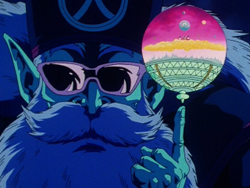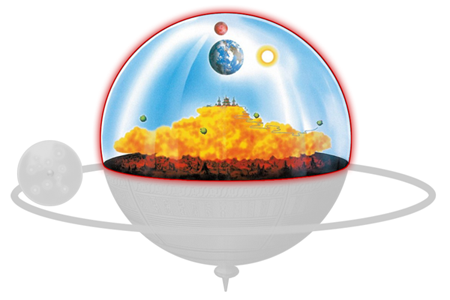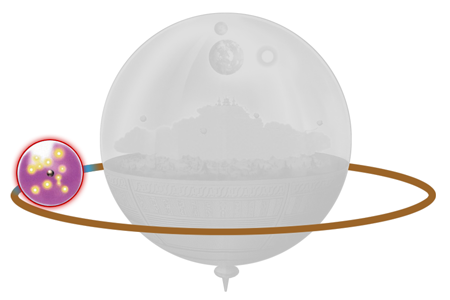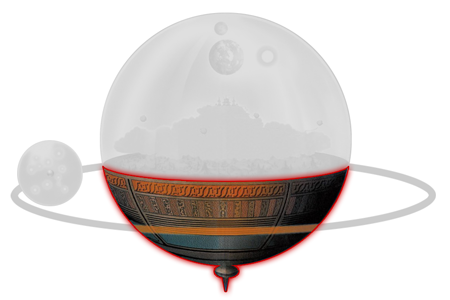The universe which forms the setting for the original Dragon Ball manga and its anime adaptations is fundamentally a giant sphere, while the 2013 theatrical film Dragon Ball Z: Battle of Gods and Dragon Ball Super expand on this by revealing that this sphere is simply one universe among twelve. The top half of the sphere is the afterlife, and the bottom half is split between the mortal realm that Goku and friends call home and the Demon Realm that Dabra rules. Outside this main sphere (referred to as the “macrocosm” for convenience), the Kaiōshin live in their own separate realm, which revolves around the macrocosm like a moon. None of this is apparent from the manga, but original author Akira Toriyama eventually drew a map of the Dragon Ball world to help convey all of this.
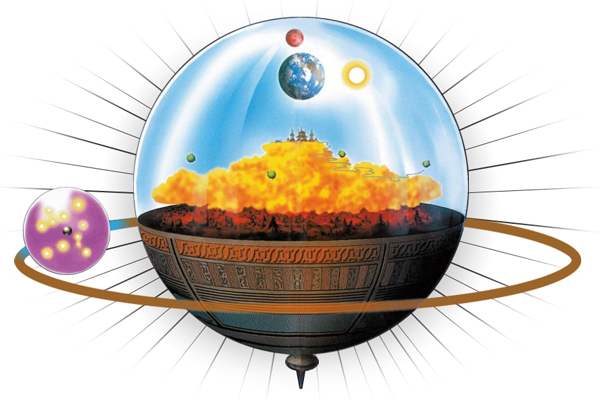
In his Super Exciting Guide: Character Volume interview, Akira Toriyama explained that he designed the world in this way to make it easy for both himself and his readers to understand.
I think it’s something I came up with so both I and the readers would be able to easily grasp it. The big ball in the center is the world known as “this world” and “the afterlife”, and the one who watches over it from outside is Kaiōshin.
— “Super Exciting Guide: Character Volume” (p. 92)
Toriyama first drew this map as a reference for the animation staff, and in fact his design of the macrocosm can be seen a bit during the Afterlife Tournament filler arc of the Dragon Ball Z TV series. He later revised the map for its inclusion in Daizenshuu 4, adding in the Kaiōshin Realm. Over the years since, versions of this map have appeared in various other guidebooks, including Daizenshuu 7, Dragon Ball Landmark, Super Exciting Guide: Character Volume, and Chōzenshū 1.
This complete map was originally background information that I drew at the request of the anime people, but I took this opportunity to add the Kaiōshin World, which was not included in the map before, to complete it. In truth, this complete world map is something I made after I finished drawing the story, to make everything consistent. (laughs)
— “Dragon Ball Daizenshuu 4: World Guide” (p. 164)
Much like our definition of “macrocosm”, for the sake of clarity, the following are terms of our own usage for the purposes of this particular guide:
- Dragon World: the sum total of everything known to exist within the Dragon Ball series, including all twelve universes, the Omni-King’s palace, the World of Void, etc.
- Universe: one of the twelve universes that exists with the Dragon World; the majority of each universe is set within a crystalline sphere that we will refer to as a “macrocosm”, with a separate Kaiōshin Realm that revolves around the macrocosm like a moon.
- Macrocosm: a giant sphere that is divided up into an afterlife and living world. Strictly speaking only the composition of Universe 7’s macrocosm is known in detail, so the following only applies to Universe 7.
- Living World: the lower half of the macrocosm; it is divided up into outer space and the Demon Realm.
- Outer Space: the upper portion of the living world, consisting of galaxies full of stars and planets; beneath it sits the Demon Realm.
- Demon Realm: the lower portion of the living world, ruled by magic and evil. This realm is inhabited by demonic yet living beings, and is not to be confused with Hell, which is part of the afterlife.
- Dragon Ball Earth: The version of Earth that exists within the Dragon Ball series; both Universe 6 and Universe 7 have their own separate versions of Earth.
- Parallel Timelines: Alternate versions of the twelve universes created through time travel. Future Trunks inhabits a devastated Earth in a parallel timeline, but this is part of an alternate version of all twelve universes, and is not to be confused with how Universe 6 and 7 each contain their own version of Earth.
Twelve Universes
Beyond the single macrocosm observed for the majority of the Dragon Ball series, it is revealed in the 2013 theatrical film Dragon Ball Z: Battle of Gods that the “Dragon World” is currently comprised of twelve separate universes. Later it is revealed that there were originally 18 universes in total, but that Omni-King destroyed six of them when slightly offended. Of these twelve remaining universes, Beerus explains that Earth exists in the 7th universe, where he is the God of Destruction. Whis provides further information on this in Dragon Ball Super episode 28 when Champa, the 6th Universe’s God of Destruction, stops by to show off some delicious food to Beerus.
This is Universe 7 and Champa-sama came here from Universe 6. These two universes are nearly identical. Their relationship is like that of twins. All things usually have a front and a back – two counterparts. For example, Universes 1 and 12. Or Universes 2 and 11. The universes whose numbers add up to 13 are counterparts.
The “World” section in Chōzenshū 4 describes Goku and co.’s universe as a huge sphere, presumably referring to the macrocosm, saying that this universe is just one of twelve. This would seem to imply that each of the twelve universes are comprised of a similar, or nearly identical, macrocosm as described above.
This world has a spherical shape overall, and what’s more, according to the God of Destruction Beerus this vast universe itself is one of twelve; it is said that the universe where Goku and the gang have their adventures is classified as “Universe 7”.
— “Dragon Ball Chōzenshū 4: Super Encyclopedia” (p. 34)
As Whis explains, any two of the twelve universes whose numbers add up to thirteen (13) are twins, or counterparts, of one another and therefore share many similarities. This is seen within the same episode where Vados, Champa’s attendant, searches Universe 6 for its version of Earth, but finds that it is now a barren sphere where humankind went extinct long ago due to some ridiculous war. The implication is that although counterpart universes are “twins”, they are not completely identical and so the same events will not always occur within both universes. This fact is further demonstrated during the team competition held between warriors from Universes 6 and 7, when Universe 6 Saiyan Cabba explains how the Saiyans of his universe still inhabit the original Saiyan homeworld Planet Sadla. While Vegeta confirms that a version of Planet Sadla used to exist in Universe 7 as well, according to him it was destroyed due to Saiyan in-fighting. Having retained their original home, the Universe 6 Saiyans remain plentiful and have evolved to no longer grow tails. Though they are a warrior-race like their Universe 7 counterparts, they do not steal planets and instead help to defeat evildoers. Vegeta also notes that Cabba’s outfit resembles what the Saiyans of Universe 7 used to wear prior to joining Freeza’s army; the style of armor now typically associated with the Universe 7 Saiyans was in fact first provided to them by Freeza.
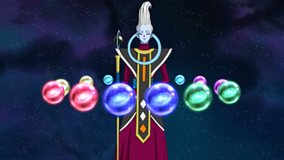
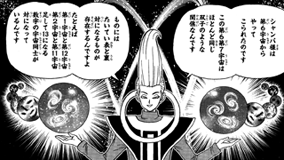
The Dragon Ball Super TV series depicts all twelve universes as crystalline spheres broadly consistent with Akira Toriyama’s diagram of Universe 7. However, unlike Akira Toriyama’s original diagram, the TV series does not show these spheres divided into upper and lower halves, or having separate Kaiōshin Realms that revolve around the rest of the universe like a moon. However, chapter 16 of the Dragon Ball Super manga depicts Universe 10 looking almost exactly like the original diagram, complete with an afterlife on top and its own separate Kaiōshin Realm. One might assume then that this same design holds true for all universes, but that the TV version leaves out these details for the sake of convenience.
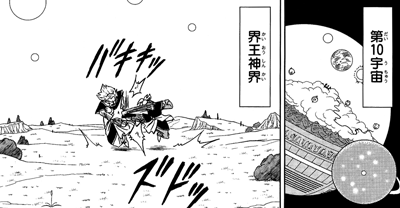
Each of the twelve universes are associated with a specific trait, and each set of paired universes often exhibit traits that are related in some way, such as Universe 1 being called the “Supreme Universe” while Universe 12 is the “Ultimate Universe”, or Universe 4 being “scheming” while Universe 9 is “underhanded”. On the other hand, Universe 3 is associated with “intelligence” while its counterpart Universe 10 is called the “Macho Universe” and focuses more on the physical side of things. A “mortal level” ranking is also assigned to each universe by the Omni-King, which is based on the average sentient level of the inhabited worlds within that given universe. Universe 7 is ranked second-to-last with a score of 3.18, with Universe 9 at the very bottom with an average level of 1.86. Universes with “mortal level” rankings of 7 or more are considered above average.
Omni-King’s Royal Palace
Translation(s): Omni-King’s Royal Palace
Somewhere outside the twelve universes lies Omni-King’s Royal Palace, which hovers atop a jellyfish-type object. The palace is constructed in the shape of 全 (zen), the kanji for “all” (used to write the “Zen” in Omni-King’s title), which is also present on the robe Omni-King wears. Surrounding the palace are twelve floating rock pillars, with one of the twelve universes hovering over each. Whis states in Dragon Ball Super episode 55 that the Omni-King’s palace is so far away from Beerus’ planet that it takes him two days to fly there. For comparison, Whis says it takes him about 26 minutes to reach North Kaiō’s planet from Beerus’ planet in episode 3.
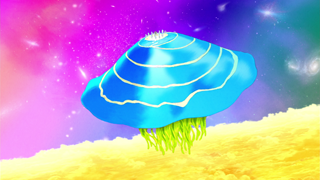
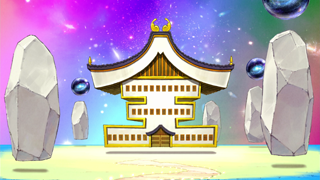
The Afterlife
Translation(s): That World, Other World, Afterlife
Also Known As: 天界 (tenkai; “Heavenly Realm”)
Other Name(s): Netherworld (Viz), Next Dimension (early FUNimation)
The “World View” section of Daizenshuu 7 divides the afterlife up into three rough areas: the lower third is Hell, ruled by King Enma; the middle third is the Enma Realm, also ruled by King Enma; and the upper third is the Kaiō Realm, ruled by the Dai Kaiō. The Enma Realm consists of Enma’s palace, the Serpent Road, and the Afterlife Airport, while the Kaiō Realm is comprised of the four Kaiō planets, Heaven, the afterlife sun, and the Dai Kaiō’s planet. For a more detailed visualization of the afterlife, see the following map.
Hell
Translation(s): Hell (lit. “Earthly Prison”)
Other Name(s): HFIL; Home for Infinite Losers (FUNimation)
Those who King Enma judge to be evil are sent to Hell. It consists of an extremely vast, rocky plain that takes up the entire lower portion of the afterlife, and is covered by the yellow clouds that surround Enma’s palace and the Serpent Road.
While Hell is never seen in the original manga, it is referred to a number of times. Akkuman, the devil who works for Uranai Baba (the “fortuneteller crone”), calls it his homeland; Daizenshuu 7 later expands on this statement, saying that devils are one of the native life-forms to Hell, but that there are others as well. Hell is again mentioned later in the series by the oni who guides Goku to the Serpent Road. He warns him to not fall off the road, because if he does he will fall into Hell and be unable to return. During the Majin Boo story arc, when Vegeta asks Piccolo if he will be able to meet Goku in the afterlife, Piccolo tells Vegeta that because he has killed too many innocent people, he will go to a different world than Goku when he dies. His body will become nothing, he will lose all his memories, and after his soul is cleansed, he will finally be reborn as a new life-form. Though Vegeta is ultimately spared this fate, this seems to be what happens to Majin Boo when he is reborn as Oob. This idea of Hell as a place where evil souls are cleansed before being reborn is very similar to the conception of Hell as seen in Buddhism.
Devil: Life-forms that live in Hell. However, [Devil] is not a general term for life-forms in Hell; it appears to refer to one race among many. Akkuman, who fought Goku in Devil’s Toilet in [Tankōbon] Volume 9, is of the Devil race.
— “Dragon Ball Daizenshuu 7: Dragon Ball Large Encyclopedia” (p. 44)
Conversely, Hell is frequently featured in the TV series and movies. In Dragon Ball Z, despite warnings from the guide oni, Goku does end up falling down into Hell while asleep on the back of the Serpent Road’s street sweeper. Goku lands in Block 1 of Hell, which is portrayed as a cartoonish parody of the standard Japanese depictions of Hell, with lakes of blood and mountains of needles. There are also small hills that look like piles of rocks, and prickly, leaf-less trees. Instead of being in torment, the spirits here seem to be having a great time, going boating out on the lake of blood and taking leisurely hikes up the mountains of needles. This parody concept of Hell was devised by Akira Toriyama for the animation staff in a memo, along with Goku’s other various adventures in the afterlife on his way to train with Kaiō.
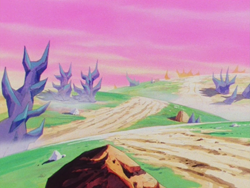
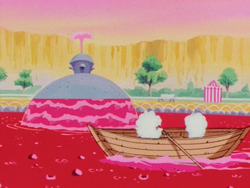
Block 1 of Hell is guarded by two oni: a red one named Gozu, and a blue one named Mezu. These two are plays on Ox-Head (Gozu) and Horse-Face (Mezu), the traditional guardians of Buddhist Hell. The Ensei Tree, which only King Enma is allowed to touch, grows in Block 1, Area 3. It bears peach-like fruit that are supposed to keep you full for 100 days, and which increase one’s power. Also in Block 1 is an exit from Hell, a tunnel connected to Enma’s desk. The yellow clouds which Goku passed right through on the way down act as a solid, impassible barrier when he tries to come back up, so Goku is forced to use the desk exit, and start running along the Serpent Road all the way from the beginning. Later, during the Freeza arc, the dead members of the Ginyu Special-Squad appear on Kaiō’s planet and fight Tenshinhan and the others, and are eventually knocked down into Hell. They land in the lake of blood, and the clouds prevent them from escaping.
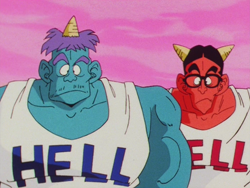

During the Afterlife Tournament filler story arc of the Dragon Ball Z TV series, Cell teams up with Freeza and his cohorts in Hell, and they run wild. They defeat the various oni guards in Hell, but are all taken out single-handedly by Paikuhan, at which point they are locked up in prison cells. During this filler sequence, Cell and company are shown looking just as they did while alive, only with halos over their head, as were Recoom and the others during the earlier filler scene with the Ginyu Special-Squad. This seems to go against the manga, which states that at this point Freeza and company ought to be spirits with no bodies in the process of being cleansed and eventually reborn. It is possible that they were attempting to be cleansed just before they went on this rampage, but this may simply be giving the filler material too much credit for a story idea that is just meant to pad out material in the TV series.
During Dragon Ball Z movie 12, Goku leads Janenba down to Hell to fight, which looks very different due to all the distortions Janenba is causing in the afterlife. The lake of blood has been changed into floating prisms of blood, the landscape is dotted with weird, people-shaped stones, and bright jelly bean-like objects fill the sky. The place seems deserted, presumably because all the damned have escaped back into the living world. It is not clear where the oni are, though Janenba does find an oni‘s club at one point, which he converts into his signature sword. However, Vegeta’s spirit is still in Hell, with a body of some sort, but when Janenba is destroyed and the afterlife returns to normal, Vegeta quickly reverts to a spirit.
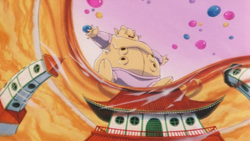
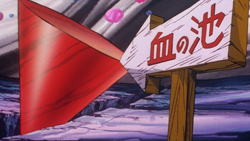
Later, in Dragon Ball GT, Hell has a very different design than in the Dragon Ball Z TV series. Instead of the cartoony, almost friendly version of Buddhist Hell previously depicted, it now looks like a black, barren wasteland. Mountains with demonic faces in them can be seen in the distance, and there are large cavernous areas. This difference in appearance could be because this is a different part of Hell than was seen previously (considering the place is over a million kilometers long), but this is really the least of the contradictions. While in the Dragon Ball Z TV series the souls of the damned are shown as looking like they did in life, just with halos, in Dragon Ball GT the damned look exactly the same as when they were alive, without even a halo to mark them as dead. It seems that in Dragon Ball GT, a halo has been changed from a generic marker of the dead to a marker of only the good dead. This means that Piccolo initially has a halo when he is in Heaven, but his halo vanishes when he tricks Enma into damning him to Hell.
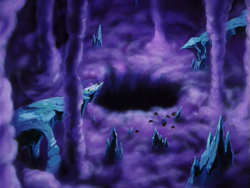
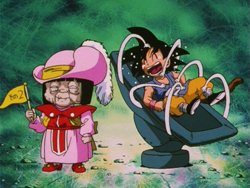
In addition to the regular portions of Dragon Ball GT Hell, there is also the Bottom of Hell, which is where Freeza and Cell dump Goku down into with their Hell Buster attack. Here, Goku is subjected to various different forms of hell, such as being boiled alive, tickled incessantly, and frozen solid by a big freezing machine, all under the surveillance of an old crone. The freezing machine is used to freeze evil people in both Heaven and Hell, but it only works on the dead; the bodies of living people are too hot for the ice spirits that the machine emits. Goku is saved by this, and uses the machine to freeze Cell and Freeza, who he then accidentally breaks (though they are later seen all in one piece again, caged and being hauled away by oni). Goku manages to “kill” Freeza and Cell a number of times before this as well, but they simply regenerate, telling Goku that because they are already dead, they can not die again. This contradicts the manga’s notion that if a dead person dies once more, they will disappear from both the living world and afterlife.
The 2015 theatrical film Dragon Ball Z: Resurrection “F” depicted Freeza being tormented in what he refers to as “Earth’s Hell” (地球の地獄), a remarkably cheerful-looking realm that seems to sit beneath a lake inside a more traditionally dark, hellish landscape. Here, Freeza hangs in a cocoon from a tree in the middle of a large field of flowers, while fairies and stuffed animals play around him. In chapter 32 of the Dragon Ball Super manga, a narration box labels this Hell as being for “Freeza only”, and Freeza assures the incredulous Goku that for him nothing is more hellish than this place. It therefore seems likely that other sinners likewise receive individualized punishments and that not everybody in Hell hangs from a tree watching stuffed animal parades.
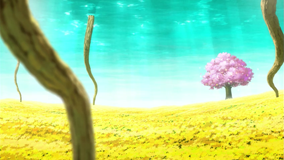
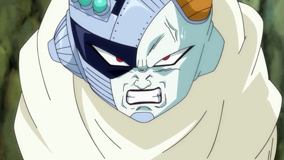
It is never explained why Freeza calls this place “Earth’s Hell”, but the term implies it is connected to the planet Earth in some way, and Freeza even believes that destroying Earth will ensure that he will never be trapped in Earth’s Hell again. This all seems difficult to reconcile with Akira Toriyama’s diagram of the cosmos, which places Hell at the bottom of the afterlife, completely separate from Earth. It is perhaps easiest to assume that Freeza is simply ignorant of the true makeup of the cosmos and incorrectly assumed his Hell was located on Earth.
The Enma Realm
Translation(s): Enma World, Enma Realm
Other Name(s): Check-In Station (FUNimation)
The Enma Realm is the general term for King Enma’s palace and the surrounding area. Enma’s palace is located in the very center of the afterlife: above Hell but below Heaven and the Dai Kaiō’s planet, and between the four Kaiōs’ planets. It serves as the entrance to the afterlife for all dead souls. As Earth’s God explains to Goku, when anyone from any planet dies, their souls come to Enma’s palace to receive judgment determining their fate in the afterlife. Souls can always be seen in front of Enma’s palace waiting to be judged, lined up on a road whose origin point is never shown onscreen.
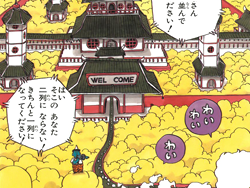
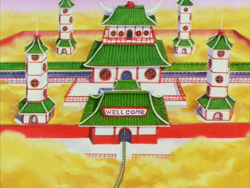
The front of Enma’s palace has a big sign reading “Well Come”; this was fixed to “Welcome” by the Majin Boo story arc, and the kanzenban release of the manga fixed it from the beginning (albeit so that it looks more like “Wel Come” than “Welcome”). Enma himself sits behind a gigantic desk, reading his grade-book that has the deeds of all the dead recorded in it. In the animated adaptation, Cell is shown being sent down to Hell by a portal that appears in front of Enma’s desk. Enma is assisted by numerous oni dressed as salary-men and wearing tiger-stripe ties.
Near Enma’s palace is the starting point for the Serpent Road, and the Afterlife Airport where planes can be taken to Heaven and the Dai Kaiō’s planet. The airport was referred to by Akira Toriyama as part of his map of the afterlife, but it only ever appears in the animated adaptation. In the Afterlife Tournament filler arc of Dragon Ball Z, the plane for Heaven is nice and fancy, but the one for the Dai Kaiō’s planet is old and rundown.
In the animated adaptation, the area around Enma’s palace includes the Café Uramesha, a café frequented by all manner of ghosts and goblins. The place is also visited by Uranai Baba, and it is here that the guide oni gives her Goku’s message that he should not be brought back to life for a year. In Dragon Ball Z movie 12, the Spirits Laundering Machine is near Enma’s palace as well. It is used to cleanse the evil from those spirits that Enma sends to Hell. Unfortunately, in the movie it explodes and covers the young oni in charge of it with concentrated evil, transforming him into Janenba.
The Serpent Road
Translation(s): Serpent Road, Snake Road, Serpentine Road
Other Name(s): Snake Way (FUNimation)
The Serpent Road is one million kilometers in length, runs from Enma’s palace all the way to North Kaiō’s planet, and those who wish to train under Kaiō must cross it. As the name implies, the road is shaped like a giant serpent. It is a rather crooked road, twisting every which way, with a few loops here and there. The road’s path is surrounded by yellow clouds as far as the eye can see, which obscure Hell below it. When Goku first travels to Kaiō’s planet, it takes him six months to cross the road, but less than two days to return to Enma’s palace after receiving Kaiō’s training. Piccolo and the others later take only a month and a half to cross the road. Prior to this, the only person to have crossed the road in the last 100 million years was King Enma.
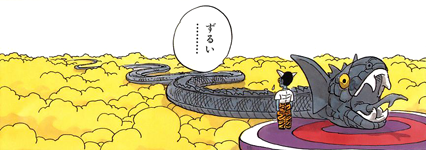
In the animated adaptation, the road’s halfway point is home to Jadōshin, the God of Serpent Road. Jadōshin is a gigantic serpent who resembles a living version of the road itself, and has haunted the road for 1,500 years. To lure in unsuspecting passersby, she disguises herself as the beautiful (and humanoid) Serpent Princess, who lives in a Japanese-style palace with her various servant girls. In reality, the palace itself and everyone inside it are all just part of Jadōshin’s massive body.
Five hundred years ago, Enma visited the Serpent Princess on his way to Kaiō’s, and she fell in love with him. The next man to visit her is Goku, who she also falls in love with; when she learns that he has a wife and kids, she transforms into her true form and tries to devour him. Goku tricks her into tying her huge serpent body into knots and escapes. Later, when Goku is rushing back across the Serpent Road to reach Earth in time, he scares the Serpent Princess’ servants when he noisily zips by the palace. A street sweeper car also appears on the Serpent Road in the animated adaptation to keep it clean. The oni who drives it lets Goku ride on the back, but he falls asleep and drops off the car into Hell.
Daizenshuu 7 states that Enma’s palace is the starting point for the roads leading to each of the Kaiōs’ planets, although no specifics are mentioned. Other than the Serpent Road, no other roads are ever shown on maps of the Dragon Ball afterlife, although logically it makes sense that there would be some way to get to the other three Kaiōs’ planets.
The Kaiō Realm
Translation(s): Kaiō World, Kaiō Realm
Each of the four Kaiō reside on their own personal planet, positioned at the afterlife’s four cardinal points. The only one of these planets seen in either the manga or animated adaptation is the North Kaiō’s planet. It is an extremely small planet that floats high above the tail end of the Serpent Road. The planet contains only North Kaiō’s one-room, dome-shaped house, a garage, a road that circles around the planet, North Kaiō’s car, and a few trees. Despite its small size, the planet has ten times the gravity of Earth, similar to Planet Vegeta (the Saiyans’ planet) and Zun (Pui-Pui’s home world). North Kaiō lives with his pet monkey Bubbles (and his cricket Gregory in the animated adaptation), spending his time counting the blades of grass, contemplating the heavens, and seeing how far he can pee. During the Cell Games the planet is destroyed by Cell’s self-destruct attack, forcing Kaiō to relocate to Heaven.
North Kaio’s planet was originally much larger. In a Q&A session within the manga’s “Full Color” release in Japan, author Akira Toriyama stated that Beerus is responsible for the planet’s current size:
It used to be so big that its diameter was about 100 times that of Kaiō’s current planet. Apart from the size it was completely the same as it is now, with nothing but grassy fields and roads. Kaiō-sama enjoyed his hobby, driving, but then one day Beerus, the God of Destruction, stopped by and they played a video game together (it was a car racing one). Beerus lost, and so the planet was destroyed by the peeved God of Destruction. Kaiō then took a large leftover fragment, whittled it down to a sphere, and built a road on it so that he could have fun driving there. This became Kaiō’s current planet.
— Akira Toriyama, Dragon Ball Full Color: Saiyan Arc Volume #03
In the extended version of the 2013 theatrical film Dragon Ball Z: Battle of Gods, the reason for Beerus destroying Kaiō’s original planet was changed to him getting angry after losing a game of hide-and-seek, while Dragon Ball Super episode 5 implies he destroyed it as a result of being served bad food during a visit 327 years earlier.
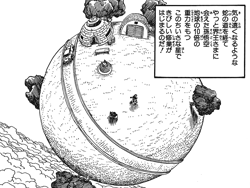
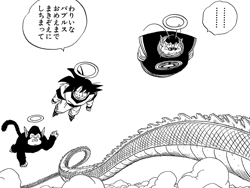
During the Afterlife Tournament filler arc in Dragon Ball Z, North Kaiō makes a bet with West Kaiō that if Goku beats Paikuhan, he will get West Kaiō’s planet (unfortunately, this scheme falls apart when Goku and Paikuhan are both disqualified). In Dragon Ball GT, he still seems to be in Heaven at the beginning of the series, but by the Super 17 arc he is at a new planet that looks just like his old one — it is unclear whether it is actually a (new) planet just for him or if the animation staff merely forgot his old planet had been destroyed. Although the other three Kaiōs’ planets are never seen in the series, they are drawn with striking resemblance to North Kaiō’s planet in Akira Toriyama’s map of the afterlife. While the series does not reveal how to reach the other Kaiōs’ planets, Daizenshuu 7 states that there are roads leading to each planet.
For the bonus Dragon Ball Super manga chapter in the Jump Victory Carnival 2015 attendee booklet, illustrator Toyotarō tells a brief, two-page story where Kaiō attempts to wish his planet back with new features, but Goku pops in saying it should be exactly the same as before (prompting Porunga to indeed restore the planet exactly as it had been before).
Heaven
Translation(s): Heaven (lit. “Heavenly Country”)
Other Name(s): Upper World (Viz)
Those who King Enma judge to be good are allowed to proceed to Heaven, a large planet directly above Enma’s palace. To reach Heaven, one must ride a special plane that takes off from an airport near Enma’s palace. This plane was first referenced as part of Akira Toriyama’s drawing of the afterlife, and while it did not appear in the manga, it was showcased in the animated adaptation. Heaven is briefly shown in the manga, as identified in the Daizenshuu, while Goku is shown training for the 25th Tenka’ichi Budōkai. Heaven is depicted as a pleasant, grassy place with rolling hills and a few round buildings. The sky has odd clouds and an unknown object (possibly Dai Kaiō’s planet) is visible at one point. With his planet destroyed and nowhere else to go, Kaiō remains in Heaven throughout the Majin Boo story arc. When Dabra is killed, King Enma decides to send him to Heaven on the logic that he would be too happy in Hell. While this fact is only ever mentioned in the manga, it is actually depicted in the animated adaptation.

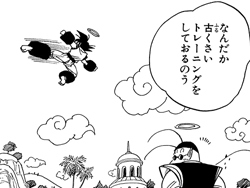
In the animated adaptation, Videl, Bulma, and company look for Gohan here after being killed by Boo. Heaven is said to be as wide as the entire universe itself, and seems to consist mostly of an immense field of flowers. Videl and the other dead people are shown as looking the same as in life from the waist upward — with ghostly tails instead of legs — and with the standard halo. Dabra is shown as now being ridiculously nice and happy now, to the point that he freaks everyone else out. In Dragon Ball GT, Piccolo comes to Heaven after dying in the destruction of Earth, but he purposefully makes Enma send him to Hell to save Goku. Kaiō also seems to still be hanging around Heaven at the start of Dragon Ball GT.
The manga states that those sent to Hell are eventually reborn as new life-forms, but it is not clarified whether those sent to Heaven stay there forever or are eventually reincarnated as well. In the Buddhist conception of the afterlife, souls in Heaven are reborn after they use up all the good karma that they accumulated in life. Since the Dragon Ball afterlife seems to be largely based on the Buddhist afterlife, it is possible that this is how Heaven in Dragon Ball works as well.
Dai Kaiō’s Planet
Translation(s): Planet Dai Kaiō, Dai Kaiō’s Planet
Other Name(s): Grand Kai’s Planet (FUNimation)
The Dai (“Grand” or “Great”) Kaiō lives on a relatively small planet that floats above Heaven, and is therefore the highest point in the afterlife and the entire macrocosm. It is never seen or mentioned in the manga, but it is included as part of Akira Toriyama’s map of the afterlife. In the animated adaptation, the Dai Kaiō’s planet appears during the Afterlife Tournament arc. It is the home of the various great martial artists from the past who have been allowed to keep their bodies in the afterlife. They train here in the hopes of eventually being able to receive Dai Kaiō’s own personal training. Goku is taken by North Kaiō here after his death in the Cell Games to train (in the manga he is only ever shown training in Heaven). This is also where the Afterlife Tournament is held to commemorate North Kaiō’s death.
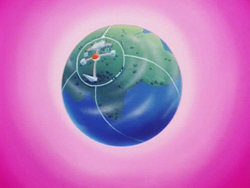
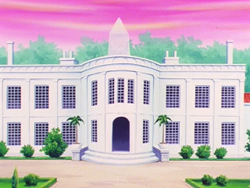
The Dai Kaiō lives in a large mansion, roughly located at what appears to be the planet’s north pole. The mansion features a mote-type circular waterway surrounding it, with obelisk-type monuments scattered around the planet. One of the many rooms inside this mansion contains an alternate dimension filled with small planets, on one of which is built an arena. It is here that the Afterlife Tournament takes place. In the animated adaptation, Majin Boo briefly appears on the Dai Kaiō’s planet and begins making a ruckus, but fortunately leaves for the Kaiōshin Realm before harming anyone.
The Kaiōshin Realm
Translation(s): Kaiōshin Realm, Kaiōshin World
Other Name(s): Planet of the Kai (FUNimation), Kaiōshin’s faraway planet (Viz)
The Kaiōshin Realm is, simply put, the Realm of the Kaiōshin. It is a special realm completely separate from the macrocosm that the afterlife, universe, and Demon Realm are all enclosed within. It is made up of a giant crystalline sphere, about a 10th the size of the macrocosm, and it revolves around the macrocosm like a moon. See the following map for a more detailed view of the Kaiōshin Realm.
Inside the Kaiōshin Realm are numerous suns (often depicted as moons in the TV series), and at the center is the Kaiōshin Planet. While the Dai Kaiō and four regular Kaiō live on separate planets separated by millions of kilometers, their superiors — the five Kaiōshin — all live together on this sacred world, which Kibito says not even the Dai Kaiō is permitted to enter. The only way to reach this realm is by teleportation; East Kaiōshin himself relies on Kibito’s Kai-Kai technique, while Goku uses his own teleportation and Boo gets here by copying Kibito-Shin’s technique.
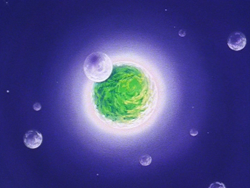
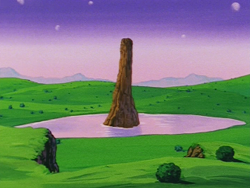
The Kaiōshin’s planet seems to be devoid of any buildings, and consists simply of grassy plains, trees, small hills, and lakes. The only real landmark on the Kaiōshins’ planet is the Z Sword’s location. In contrast, it is shown during the “Future Trunks” story arc of Dragon Ball Super that the Kaiōshin planet of Universe 10 features an ornate building, with an open courtyard in the center, residence quarters around the exterior, and a large “kai” (界) kanji at the front gate. It is possible that the Kaiōshin of each universe are responsible for constructing their own residences, or that the residences on the Kaiōshin planet in Universe 7 were destroyed during the initial battle with Boo at the time Dai Kaiōshin was absorbed. The Elder Kaiōshin describes this planet as especially durable, so it would be possible for the planet to survive while any structures are destroyed, just as the planet was significantly damaged during the final battle with Boo.
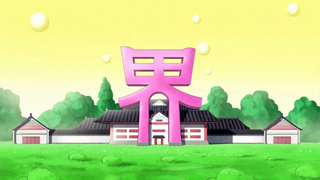
The Kaiōshin Realm’s unique position outside the macrocosm enables the Kaiōshin to oversee both the afterlife and universe, although even their eyes cannot view the Demon Realm. More prosaically, Akira Toriyama states in Daizenshuu 4 that he drew the original version of the Dragon Ball cosmos map as background info for the anime staff, but did not include the Kaiōshin Realm at this point (presumably because it had not shown up in the story yet). It was only after Dragon Ball ended that Toriyama added the Kaiōshin Realm to the map, and its position as separate from everything else is probably because of the fact that it was tacked on later like this.
This complete map was originally background information that I drew at the request of the anime people, but I took this opportunity to add the Kaiōshin World, which wasn’t included in the map before, to complete it. In truth, this complete world map is something I made after I finished drawing the story, to make everything consistent. (laughs)
— “Dragon Ball Daizenshuu 4: World Guide” (p. 169)
The Kaiōshin realm is so far removed from the macrocosm that East Kaiōshin and Kibito are astonished that they can sense Super Saiyan 3 Goku’s ki when he fights Boo on Earth. Despite this distance, the Kaiōshins’ godly eyes still enable them to oversee conditions in the macrocosm; in particular, Elder Kaiōshin likes to watch women as they change. In the TV series’ flashback showing Boo’s origin, the five Kaiōshin are shown living peacefully on their planet, fishing and goofing around.
Planet Kai-Shin
Translation(s): Planet World-Core
Planet Kai-Shin is located in an unknown part of the macrocosm, and is described as a larger version of the planets that each of the Kaiō live on. The planet is home to the gigantic “World Tree” (界樹; kaiju), whose fruit give birth to a race known as the Shin-jin (芯人), or “Core People”. The Shin-jin are neither male nor female, and their average lifespan is about 75,000 years. There are roughly 80 Shin-jin living on Planet Kai-Shin, and they spend their days living peacefully, studying various topics in a large castle. The Shin-jin are clairvoyant, have telepathic powers and the ability to materialize objects through mere thought. When one of the five Kaiō dies, a replacement is chosen from among the Shin-jin by lottery. Very rarely, the World Tree produces a golden fruit, from which a special type of Shin-jin is born, far more powerful and capable of living for millions of years. Only the Shin-jin born from the rare golden fruit are selected by lottery to serve as Kaiōshin.
When Akira Toriyama first explained the existence of the Shin-jin in his interview in the Super Exciting Guide: Character Volume, it was left unclear whether they had randomly taken it upon themselves to becomes gods, organizing and overseeing the cosmos, or if they had been strategically placed within the macrocosm and provided some direction for governance from a higher authority. However, with the appearance of Zen’ō and the revelation of twelve similarly-structured universes, it is possible that Zen’ō or the Great Priest played a significant role in establishing the governing structure and hierarchy seen in each universe. As each universe is shown to have at least a Kaiōshin, it could potentially be assumed that each universe must at least also have their own Planet Kai-Shin inhabited by Shin-jin. While yet to be officially stated anywhere, it is possible that however, and whenever, the universes were created, that a “World Tree” was planted in each universe and the Shin-jin first born from these trees were provided instructions as to how their specific universe should be organized and governed.
The Living World
Translation(s): This World (in contrast to “That World”, the afterlife)
Also Known As: 現世 (gensei; “Present World”)
The living world is the lower half of the macrocosm. It is perfectly sealed within opaque walls marked with strange patterns, in contrast to the transparent crystalline dome that covers the afterlife. The living world is split into two dimensions described as being like the two sides of a coin. The top half is outer space, overseen by the Kaiō and Kaiōshin, and run according to science (or what passes for it in the Dragon Ball world). The bottom half is the Demon Realm, where magic has more sway than science, and where the evil Makaiō and Makaiōshin are gods. Despite the two dimensions being polar opposites, when beings from either one die their spirits still travel to the afterlife with no distinction. There are apparently other dimensions that can be accessed from the living world (such as the Room of Spirit and Time, and Sugoroku Space in Dragon Ball GT), but it is unclear where they fit into the grand scheme of things. Click the following map for a more detailed view of the Living World.
Outer Space
Translation(s): Universe, Space, Outer Space
Outer space is the upper portion of the living world, and is the realm where Goku and the other main characters live. It is the only portion of the Dragon Ball world that even remotely resembles reality, being based off of the actual universe. As such it consists of planets, stars, and other celestial bodies. Daizenshuu 7 explains that in the Dragon Ball universe a collection of planets forms a nebula, and a collection of nebulas forms a galaxy; in actual modern astronomy, nebula are collections of space dust and gas rather than planets, though the term was originally much broader and did include galaxies. Galaxies within Universe 7 are divided up into north, south, east, and west. Universe 10 seems to follow this same scheme, as the Dragon Ball Super manga states that Zamasu was previously Universe 10’s North Kaiō, but it is unknown how or if the other universes are divided up.
The universe is divided into four galaxies, and in addition to these, a chaotic place known as the Demon Realm also exists somewhere in the universe. The East, West, North, and South Galaxy sections [of the universe] only utilize Gods as administration units, and the lifeforms who reside in the Living World are able to freely travel the galaxies. Of course, that is supposing they have the technology…
— “Dragon Ball Daizenshuu 7: Dragon Ball Large Encyclopedia” (p. 36)
These divisions serve as the governing areas for the gods, and so each one is overseen by the Kaiō and Kaiōshin with the corresponding cardinal direction in their title. As quoted above, Daizenshuu 7 states that the “galaxies” in Dragon Ball are merely administrational units used by the gods, and so there is nothing stopping races from travelling from one galaxy to another, provided they have the technology to do so. These “galaxies” do not have physical divisions between them, and can be considered as borders drawn on a map between countries. It is not clear what significance the cardinal directions could have in space, but the map of the Dragon Ball world shows what appear to be division lines between galaxies engraved into the living world’s outer walls.
According to Dragon Ball Super, Universe 7 currently contains only 28 planets inhabited by mortals (presumably meaning sentient life), although in his Super Exciting Guide: Character Volume interview, Akira Toriyama estimates that Freeza himself had controlled hundreds of planets, not including the ones he destroyed. Among these inhabited planets is Earth, located on the outskirts of the North Galaxy, which Daizenshuu 7 states is home to many beautiful planets similar to it. Other than Earth, there is little mention of what specific galaxies planets are located in. Based on dialogue, it is inferred that Planet Namek is located somewhere outside the North Galaxy. During the end of the Freeza arc, North Kaiō explains that he can not do anything to help revive Goku or Kuririn because they died on Plant Namek, which is outside of his region. Some translations make it sound as if Kaiō is referring to the area of death as being outside his jurisdiction, as it is Enma’s duty, but the word used for “region” (地域; chi’iki) in this instance implies a physical region. Furthermore, Bulma states shortly thereafter that Planet Namek is located outside of Kaiō’s region, though this line is left out in Viz’s English translation of the manga.
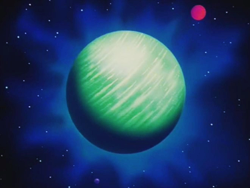
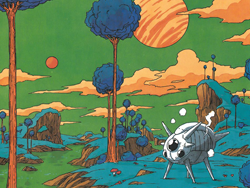
While it is never explicitly stated in which galaxy Planet Namek is located, some educated guesses about its location can be made. The maps of the Dragon Ball world that do showcase planets always place Earth and Namek as being on opposite sides of one of the galaxy-dividing lines etched into the macrocosm’s side. Based on this, it can be assumed that Namek would be in either the East or West Galaxy, but unfortunately it is not easily distinguishable exactly which galaxy it is in due to the side-perspective of the map. However, the Elder Kaiōshin does state that he warned the Namekians about using the Dragon Balls, and as he is the East Kaiōshin of 15 generations ago, it would be logical to infer that Planet Namek would therefore be in his region of the East Galaxy. The map of the Dragon Ball world also indicates that Planet Vegeta and Planet Freeza No. 79 are within the same galaxy as Planet Namek.
Of the limited information available about the South Galaxy, the majority of it is revealed in the animated adaptation. In the manga, the South Kaiō brags to North Kaiō about his pupil Papoi — supposedly the strongest fighter from the South Galaxy — but he quickly loses confidence that Papoi is a match for Goku after watching him train in Heaven. In Dragon Ball Z movie 13, Tapion’s home planet of Konats is said to be located in the South Galaxy, which is unfortunately also the galaxy Broli is said to destroy in Dragon Ball Z movie 8. In the Afterlife Tournament filler story arc, Olibu says that the South Galaxy must be very peaceful, since the Southern warrior Catepy’s special attack is to simply tickle people.
Very little is known about the history or creation of the universe. The only solid information available revolves around the destruction of various areas of the universe. As Kaiōshin explains in chapter 445, five million years ago when humans on Earth were just beginning to walk upright, Majin Boo destroyed hundreds of planets in the space of only a few years before being sealed away. The historical timeline of “Dragon World” events provided in Daizenshuu 7 shows that the Legendary Super Saiyan ravaged the universe 1,000 years ago. More recently, in Age 737 (12 years before Dragon Ball begins), Planet Vegeta was destroyed by Freeza. In Dragon Ball Z movie 9, Bojack and his crew are said to have rampaged throughout the universe before being sealed away by the four Kaiō at the edge of the universe. All of this destruction (to say nothing of Beerus’ actions) may be the reason Universe 7 is now down to only 28 inhabited planets.
Virtually all sentient species in the “Dragon World” are humanoid. In fact, the term “human” (人間; ningen) is used throughout the series as a catch-all term for just about any sentient race, as opposed to just Earthlings. For example, in the manga Vegeta refers to regular Saiyans as “human” (in contrast to their Ōzaru form) and Ginyu describes himself as the kind of “human” who can control his battle power. More recently, Dragon Ball Super contains numerous instances of 人間 (ningen) being used as a general term to refer to any non-divine being from any planet or universe. As a result, it has become common for official translations of the series to translate the term as “mortal” to reflect this broader meaning, although even the gods of the “Dragon World” can be killed and should technically qualify as “mortal” themselves.
Many races throughout the universe also have the ability to transform, some for camouflage and some to conserve energy. Zarbon identifies himself and Freeza as belonging to this final group, which he describes as “transforming-type aliens”. According to Ginyu, races that are able to raise and lower their battle power at will without transforming are quite rare.
The Galactic Patrol is in charge of protecting the peace throughout the galaxy. Scout robots are occasionally sent out to observe planets (one in every hundred thousand flies on Earth is actually a scout robot), while other times actual members of the patrol themselves are dispatched. There are 38 members of the Galactic Patrol, which handle the limited number of planets with intelligent lifeforms. When Jaco applied, there were nine applicants for five open positions. The Galactic Patrol is overseen by the Galactic King. Members of the patrol have access to various knowledge databases that can be directly inserted into a patrolman’s brain, including alien languages and that of mechanical repair. Special ear receivers can hear the sounds an ant makes more than 100 meters away. Even older models of Galactic Patrol ships have gravity control devices and store energy inside the mass of a certain type of metal (with copper being an Earth equivalent).

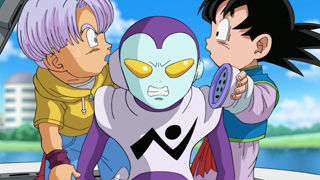
Depending on the circumstances, Galactic Patrol duties may include saving a species or eradicating it; to accomplish the latter, the patrol may use an extinction bomb specially made to spread a virus affecting only a particular species. Jaco once mistakenly eradicated a planet’s population, much to the annoyance of his boss. By Galactic Patrol standards, Earth is not a particularly important planet; the Galactic King admits that even a klutz like Jaco is capable of handling a mission there, and gives Jaco the authority to eradicate its population if he so desires.
While Galactic Patrol members are capable fighters, they are no match for certain aliens such as adult Saiyans or Freeza, nor will their extinction bomb work against them. This fact was previously stated in Daizenshuu 7, prior to the appearance of the Galactic Patrol in the series proper.
A “Galactic Police Organization” exists in the universe. However, they lack the fighting ability to oppose Freeza and the Saiyans.
— “Dragon Ball Daizenshuu 7: Dragon Ball Large Encyclopedia” (p. 44)
Additionally, the background information published in Akira Toriyama: The World Anime Special on Tullece’s henchmen states that Amond was originally a galactic criminal imprisoned by the Galactic Police on Planet Nutts before being freed by Tullece. There are also instances of interplanetary cooperation efforts in Dragon Ball GT, such as Planet Pital functioning as large hospital serving patients from many different planets.
As stated in Daizenshuu 7, every sentient race throughout the universe speaks an established “universal official language” that allows them to communicate without issue. It is never elaborated on how this standard language originated, or why it is used on planets such as Earth, which do not have contact with other planets. Even gods are shown to speak this standard language among themselves, as do beings from the Demon World like Dabra.

Despite the existence of a standard language, there are also races that speak their own native languages, such as Namekian. In Dragon Ball chapter 252 when Freeza and co. attack Dende’s village, Muri starts out speaking to Freeza in Namekian, but Freeza cuts him off and tells him to instead “speak with words which we can understand”, since he knows they can. Supplemental Dragon Ball Z movie 5 information published in Weekly Shōnen Jump 1991 #25 states that Sauzer knows over 7,000 languages, so it can be assumed that there must be at least that many languages spoken throughout the universe. In spite of the fact that aliens and Earthlings speak the same language, they seem to have completely different alphabets and numeric systems, such as seen on unconverted scouters or screens in space ships.
Lord Zuno explains in Dragon Ball Super episode 31 that one must speak the divine “language of the gods” in order to make a wish with the Super Dragon Balls. Whis later translates Beerus’ wish into the language of the gods for Super Shenlong, which turns out to actually just be the universal official language spoken backwards, syllable by syllable. Outside of using the language of the gods to communicate with Super Shenlong, the gods are never shown speaking it among themselves.
Beerus’ Planet
Translation(s): Beerus’ Planet, Planet Beerus
Also Known As: ビルスの城 (birusu no jō; “Beerus’ Palace”)
Located somewhere within outer space, God of Destruction Beerus lives here with his attendant Whis. The planet has a pyramid motif, with the lower part resembling an inverted quadrangular pyramid and a number of spiraling buildings are built on top of it so that they enter a thick tree. The inside of the castle consists of Beerus’ sleeping chamber, a bathing area, and a few dining areas, with one surrounded by a huge aquarium. Beerus’ bed floats in the middle of the sleeping chamber, surrounded by numerous explosive alarm hourglasses. The landscape around the castle is well-vegetated with trees and features a courtyard area with gardens.
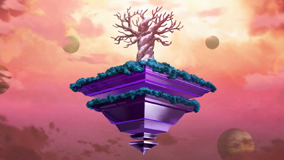
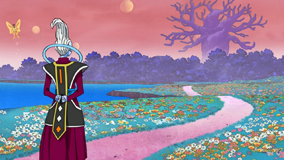
Although the exact location of Beerus’ planet is unknown, the geographical dictionary in Chōzenshū 4 says it is outer space (as opposed to the afterlife). Whis tells Beerus in Dragon Ball Super episode 3 that it will take them 26 minutes to reach North Kaiō’s planet from their own world, while later in episode 23, he explains to Goku that it will take them 35 minutes to get from there to Earth.
The Demon Realm
Translation(s): Demon Realm, Demon World
Other Name(s): The Underworld, The Netherworld, The Spirit World
Also Known As: 悪魔界 (akumakai; “Devil Realm”), 暗黒魔界 (ankoku-makai; “Demon Realm of Darkness”)
The Demon Realm is the lower half of the living world, a dimension that exists on the reverse side of outer space. It is not to be confused with Hell, which exists in the afterlife. According to Daizenshuu 7, the Demon Realm is a chaotic place where magic has more influence than science. The Kaiō and Kaiōshin themselves do not really understand the Demon Realm, as not even the gods’ eyes can reach it. As a result, not much is known about it other then that it is the home of evil life-forms. Daizenshuu 7 recounts these life-forms interfering with the peace of the universe’s planets. In fact, it states that one of the factors in the 43 nations of the Dragon Ball Earth unifying into a single world state was to guard against such threats from the Demon Realm.
Similar to the divisions of outer space into four cardinal directions, the Demon Realm is divided into several different spatial areas, though it is unknown how many there are or what these divisions are based on. All of these areas are unified under the rule of Dabra, the king of the Demon Realm, who according to Kaiōshin was its strongest resident until being brainwashed by the wizard Bobbidi into becoming his servant. Dabra has been working for Bobbidi for at least the last 300 years and it is not known if anyone else has taken control of the Demon Realm in Dabra’s absence.
According to Akira Toriyama in his Super Exciting Guide: Character Volume interview, the Demon Realm has its own special gods, the “Makaiō” and “Makaiōshin”. They are the antitheses of the Kaiō and Kaiōshin, and govern evil. For more information about the Makaiō and Makaiōshin, visit the “God Hierarchy” section of this guide.
The Demon Realm is never officially shown in the manga, but when Gohan faces off against Dabra, Bobbidi teleports them to some different world, one of rocky plains and blood-red water. Since Bobbidi transported his other henchmen Pui-Pui and Yakon to their respective home worlds during their fights with Goku and company, it is possible that this is actually the Demon Realm. When Dabra dies, King Enma sends him to Heaven on the reasoning that he would be happy to go to Hell. This implies that Hell and the Demon Realm are similar, and in fact the place where Gohan and Dabra fight does somewhat resemble Hell as seen in the animated adaptation.
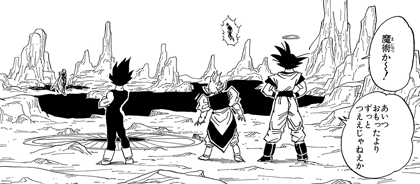
The Demon Realm is featured in Dragon Ball episode 81, when Goku travels there through the Demon Realm Gate in order to rescue Princess Misa, who was kidnapped by Shura, the martial arts master of the Demon Realm. This reference is made years before the Demon Realm was ever mentioned in the manga, although it should be noted that the “Demon World” is a fairly generic term that pops up in numerous manga and anime series, so its use here is likely a coincidence. In the episode Goku visits a village being attacked nightly by beings from the Demon Realm. In another premonition of things to come, the inhabitants of the Demon Realm are called majin in this episode, with females being called majo, literally “demon woman” but generally used to mean “witch”. These fiends are coming to mortal realm through the Demon Realm Gate, a portal in a cave linking the living world to the afterlife. This portal is only supposed to be used by grim reapers, who are authorized to do so by King Enma and God.
This filler version of the Demon Realm has several inconsistencies between the Demon Realm that later figures in the Majin Boo arc (such as the Demon Realm apparently being part of the afterlife), as would be expected from filler material that existed many years before the original author would independently visit such types of ideas.


